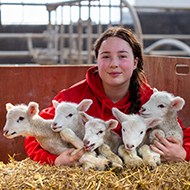
Extremely rare litter marks a memorable lambing season.
Staff and students at Hartpury University and College were astounded when one of the institution's 650 ewes gave birth to quintuplet lambs at the on-site commercial farm in Gloucestershire.
Farm manager Andrew Eastabrook has worked in farming for 14 years. He said: “In all my years working in agriculture I’ve never come across a set of quintuplet lambs – it’s very special indeed.
“Apparently the chances of a ewe giving birth to quintuplets are a million to one, and it’s even rarer for them to be born alive and well.”
Scans carried out on the mother during pregnancy showed that it was carrying four lambs – a rarity in itself, as ewes typically have a maximum of three lambs at once.
When the mother eventually gave birth to just three lambs staff assumed the scans must have been wrong and moved the animal into a separate pen to rest.
“When we came back 35 minutes later to check on [the mother's] welfare, there were another two lambs – we were literally counting sheep!” Said Mr Eastabrook.
All five lambs are healthy, weighing roughly 3.5kg each. Three of them have stayed with their mother, which is also doing well, but the other two are now with foster mothers to ensure that they get enough milk.
Mr Eastabrook concluded: “We’re keeping a close eye on them, as we do with all our animals, but they’ve settled in well and are obviously completely unaware of the excitement that their arrival has created.”
Image (c) Hartpury.



 FIVP has shared a survey, inviting those working in independent practice to share their views on the CMA's proposed remedies.
FIVP has shared a survey, inviting those working in independent practice to share their views on the CMA's proposed remedies.